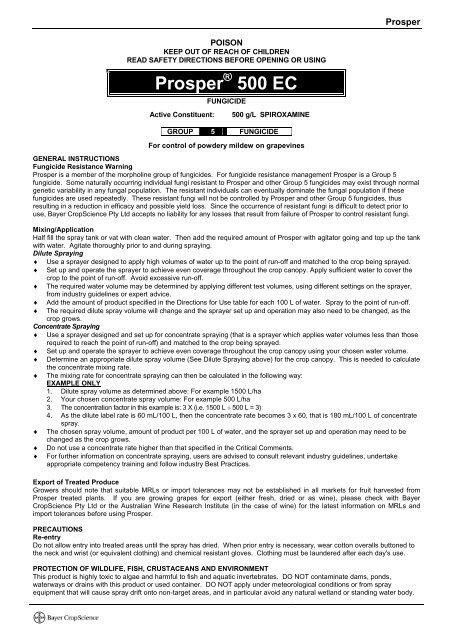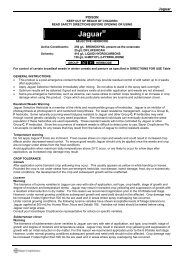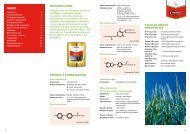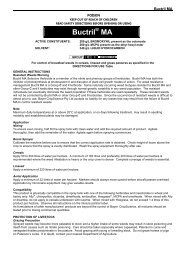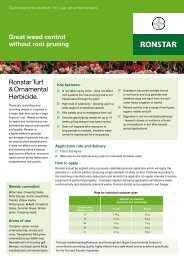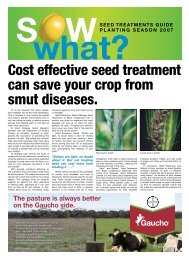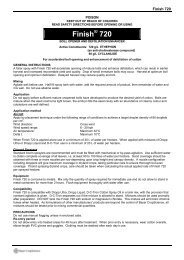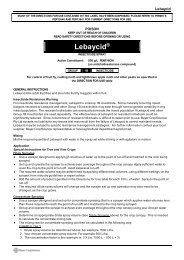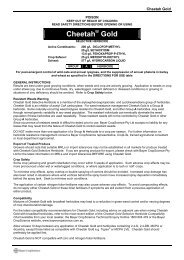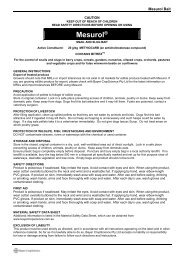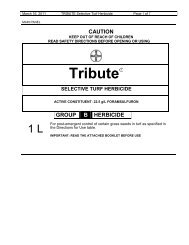Prosper 500 EC - Bayer CropScience
Prosper 500 EC - Bayer CropScience
Prosper 500 EC - Bayer CropScience
You also want an ePaper? Increase the reach of your titles
YUMPU automatically turns print PDFs into web optimized ePapers that Google loves.
POISON<br />
KEEP OUT OF REACH OF CHILDREN<br />
READ SAFETY DIR<strong>EC</strong>TIONS BEFORE OPENING OR USING<br />
<strong>Prosper</strong> ® <strong>500</strong> <strong>EC</strong><br />
FUNGICIDE<br />
Active Constituent: <strong>500</strong> g/L SPIROXAMINE<br />
GROUP 5 FUNGICIDE<br />
For control of powdery mildew on grapevines<br />
<strong>Prosper</strong><br />
GENERAL INSTRUCTIONS<br />
Fungicide Resistance Warning<br />
<strong>Prosper</strong> is a member of the morpholine group of fungicides. For fungicide resistance management <strong>Prosper</strong> is a Group 5<br />
fungicide. Some naturally occurring individual fungi resistant to <strong>Prosper</strong> and other Group 5 fungicides may exist through normal<br />
genetic variability in any fungal population. The resistant individuals can eventually dominate the fungal population if these<br />
fungicides are used repeatedly. These resistant fungi will not be controlled by <strong>Prosper</strong> and other Group 5 fungicides, thus<br />
resulting in a reduction in efficacy and possible yield loss. Since the occurrence of resistant fungi is difficult to detect prior to<br />
use, <strong>Bayer</strong> <strong>CropScience</strong> Pty Ltd accepts no liability for any losses that result from failure of <strong>Prosper</strong> to control resistant fungi.<br />
Mixing/Application<br />
Half fill the spray tank or vat with clean water. Then add the required amount of <strong>Prosper</strong> with agitator going and top up the tank<br />
with water. Agitate thoroughly prior to and during spraying.<br />
Dilute Spraying<br />
♦ Use a sprayer designed to apply high volumes of water up to the point of run-off and matched to the crop being sprayed.<br />
♦ Set up and operate the sprayer to achieve even coverage throughout the crop canopy. Apply sufficient water to cover the<br />
crop to the point of run-off. Avoid excessive run-off.<br />
♦ The required water volume may be determined by applying different test volumes, using different settings on the sprayer,<br />
from industry guidelines or expert advice.<br />
♦ Add the amount of product specified in the Directions for Use table for each 100 L of water. Spray to the point of run-off.<br />
♦ The required dilute spray volume will change and the sprayer set up and operation may also need to be changed, as the<br />
crop grows.<br />
Concentrate Spraying<br />
♦ Use a sprayer designed and set up for concentrate spraying (that is a sprayer which applies water volumes less than those<br />
required to reach the point of run-off) and matched to the crop being sprayed.<br />
♦ Set up and operate the sprayer to achieve even coverage throughout the crop canopy using your chosen water volume.<br />
♦ Determine an appropriate dilute spray volume (See Dilute Spraying above) for the crop canopy. This is needed to calculate<br />
the concentrate mixing rate.<br />
♦ The mixing rate for concentrate spraying can then be calculated in the following way:<br />
EXAMPLE ONLY<br />
1. Dilute spray volume as determined above: For example 1<strong>500</strong> L/ha<br />
2. Your chosen concentrate spray volume: For example <strong>500</strong> L/ha<br />
3. The concentration factor in this example is: 3 X (i.e. 1<strong>500</strong> L ÷ <strong>500</strong> L = 3)<br />
4. As the dilute label rate is 60 mL/100 L, then the concentrate rate becomes 3 x 60, that is 180 mL/100 L of concentrate<br />
spray.<br />
♦ The chosen spray volume, amount of product per 100 L of water, and the sprayer set up and operation may need to be<br />
changed as the crop grows.<br />
♦ Do not use a concentrate rate higher than that specified in the Critical Comments.<br />
♦ For further information on concentrate spraying, users are advised to consult relevant industry guidelines, undertake<br />
appropriate competency training and follow industry Best Practices.<br />
Export of Treated Produce<br />
Growers should note that suitable MRLs or import tolerances may not be established in all markets for fruit harvested from<br />
<strong>Prosper</strong> treated plants. If you are growing grapes for export (either fresh, dried or as wine), please check with <strong>Bayer</strong><br />
<strong>CropScience</strong> Pty Ltd or the Australian Wine Research Institute (in the case of wine) for the latest information on MRLs and<br />
import tolerances before using <strong>Prosper</strong>.<br />
PR<strong>EC</strong>AUTIONS<br />
Re-entry<br />
Do not allow entry into treated areas until the spray has dried. When prior entry is necessary, wear cotton overalls buttoned to<br />
the neck and wrist (or equivalent clothing) and chemical resistant gloves. Clothing must be laundered after each day's use.<br />
PROT<strong>EC</strong>TION OF WILDLIFE, FISH, CRUSTACEANS AND ENVIRONMENT<br />
This product is highly toxic to algae and harmful to fish and aquatic invertebrates. DO NOT contaminate dams, ponds,<br />
waterways or drains with this product or used container. DO NOT apply under meteorological conditions or from spray<br />
equipment that will cause spray drift onto non-target areas, and in particular avoid any natural wetland or standing water body.
<strong>Prosper</strong><br />
STORAGE AND DISPOSAL<br />
Store in the closed, original container in a cool, well ventilated area. Do not store for prolonged periods in direct sunlight.<br />
The method of disposal of the container depends on the container type. Read the ‘STORAGE AND DISPOSAL’ instructions on<br />
the label that is attached to the container.<br />
SAFETY DIR<strong>EC</strong>TIONS<br />
Harmful if swallowed. Will damage the eyes and skin. Repeated exposure may cause allergic disorders. Avoid contact with eyes<br />
and skin. When opening the container and preparing the spray wear cotton overalls buttoned to the neck and wrist and a<br />
washable hat, elbow-length chemical resistant gloves and goggles. When using the prepared spray wear cotton overalls<br />
buttoned to the neck and wist and a washable hat. If clothing becomes contaminated with product, remove clothing<br />
immediately. If product on skin, immediately wash the area with soap and water. If product in eyes, wash it out immediately with<br />
water. Wash hands after use. After each day’s use wash gloves, goggles and contaminated clothing.<br />
FIRST AID<br />
If poisoning occurs, contact a doctor or Poisons Information Centre (telephone 13 11 26).<br />
MATERIAL SAFETY DATA SHEET<br />
Additional information is listed in the Material Safety Data Sheet, which can be obtained from www.bayercropscience.com.au.<br />
EXCLUSION OF LIABILITY<br />
This product must be used strictly as directed, and in accordance with all instructions appearing on the label and in other<br />
reference material. So far as it is lawfully able to do so, <strong>Bayer</strong> <strong>CropScience</strong> Pty Ltd accepts no liability or responsibility for loss<br />
or damage arising from failure to follow such directions and instructions.<br />
<strong>Prosper</strong> ® is a Registered Trademark of <strong>Bayer</strong>.<br />
APVMA Approval No.: 52817/53712<br />
DIR<strong>EC</strong>TIONS FOR USE<br />
CROP DISEASE RATE CRITICAL COMMENTS<br />
Grapevines Powdery Dilute spraying Apply thoroughly as part of the following 5 spray program:<br />
mildew 60 mL/100 L<br />
1. when shoots 10-20 cm long.<br />
2. pre-flowering.<br />
Concentrate<br />
3. flowering.<br />
spraying<br />
4. after fruit set.<br />
Refer to the<br />
5. before bunches close.<br />
Mixing/<br />
Do not allow spray intervals in the above program to exceed 21<br />
Application days. In some seasons, additional non-schedule sprays may be<br />
section<br />
necessary later in the season.<br />
Do not apply more than 2 consecutive <strong>Prosper</strong> sprays per season.<br />
Apply a maximum of 3 <strong>Prosper</strong> sprays per season. Do not apply<br />
more than one <strong>Prosper</strong> spray late season.<br />
Apply by dilute or concentrate spraying equipment. Apply the<br />
same total amount of product to the target crop whether applying<br />
this product by dilute or concentrate spraying methods. Do not use<br />
in equipment that requires rates greater than 180 mL/100 L of<br />
water (3X). Do not apply in water volumes less than 250 L/ha.<br />
NOT TO BE USED FOR ANY PURPOSE, OR IN ANY MANNER, CONTRARY TO THIS LABEL UNLESS AUTHORISED<br />
UNDER APPROPRIATE LEGISLATION<br />
WITHHOLDING PERIOD:<br />
Grapes (for domestic consumption): DO NOT HARVEST FOR 4 WEEKS AFTER APPLICATION<br />
Grapes (for produce intended for export): CONSULT YOUR WINERY, INDUSTRY SPRAY DIARY OR PEAK INDUSTRY<br />
BODY FOR THE R<strong>EC</strong>OMMENDED WITHHOLDING PERIOD


